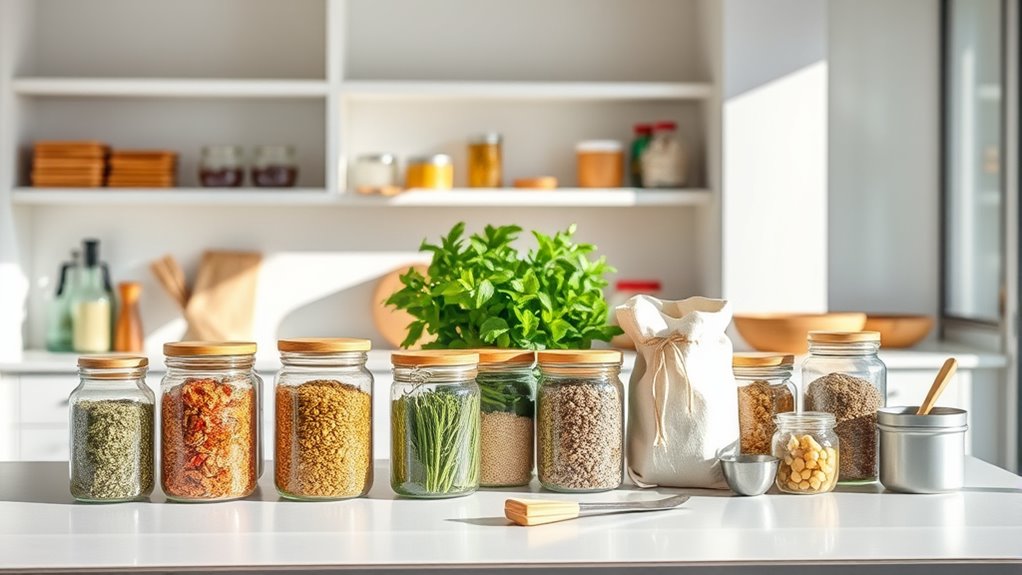Creating a zero-waste kitchen starts with stocking a package-free pantry by shopping in bulk using reusable containers and cloth bags, which cuts down on packaging waste and saves money. Organize and label your supplies to minimize clutter and improve freshness. Incorporate composting to handle food scraps responsibly and turn waste into garden nutrients. When you adopt these habits, you’ll build a sustainable, clutter-free kitchen. Keep exploring to discover how these steps come together seamlessly.
Key Takeaways
- Shop for bulk staples using reusable containers to avoid packaging waste and support sustainable practices.
- Organize your pantry with clear, labeled jars to maintain freshness and minimize clutter.
- Use refillable bags or jars at stores to purchase without single-use plastics.
- Incorporate composting for food scraps to reduce organic waste and enrich your garden.
- Establish consistent routines for storage, shopping, and composting to sustain a zero-waste kitchen.

A zero-waste kitchen transforms how you cook and manage resources by minimizing trash and maximizing reuse. One of the most effective ways to achieve this is through bulk shopping, which allows you to buy staples like grains, nuts, spices, and legumes in large quantities without packaging waste. Instead of relying on single-use plastic bags or containers, you bring your own reusable jars or cloth bags to fill at the store. This not only reduces packaging waste but also often saves you money over time. When you shop in bulk, you control portion sizes, helping to cut down on food waste at home. Plus, many bulk stores encourage sustainable practices, making it easier for you to stick to your zero-waste goals. Incorporating zero-waste shopping strategies can further enhance your efforts and help you find local stores that support sustainable packaging options.
Once you’ve gathered your bulk supplies, it’s essential to store them properly to maintain freshness and avoid clutter. Clear, reusable containers help you keep track of your pantry items and prevent unnecessary packaging. Labeling each jar or container with the contents and purchase date keeps your pantry organized and ensures you use ingredients before they expire. Over time, these habits contribute to a package-free pantry, where every ingredient has a designated space, and waste is minimized.
Proper storage with clear, reusable containers and labels keeps your pantry organized, fresh, and waste-free over time.
A zero-waste kitchen also relies heavily on composting methods to handle organic waste responsibly. Composting turns food scraps like vegetable peels, coffee grounds, and eggshells into nutrient-rich compost that benefits your garden or houseplants. You can choose from various composting methods—such as traditional compost bins, worm composting (vermicomposting), or Bokashi systems—based on your space and lifestyle. Each method reduces landfill waste and decreases methane emissions associated with food decomposition in landfills. Setting up a compost system nearby ensures that your kitchen remains free of organic waste, and it provides a sustainable way to close the loop on food scraps.
Incorporating these practices into your daily routine makes your kitchen more sustainable and less reliant on packaging. Bulk shopping not only cuts down on waste but also encourages mindful purchasing—buy only what you need, reducing excess. Meanwhile, composting methods help you handle unavoidable waste responsibly, turning scraps into a resource rather than trash. Together, these strategies empower you to create a truly zero-waste kitchen, where every element serves a purpose and waste is minimized at every stage. With consistent effort, you’ll find that managing your kitchen becomes simpler, cleaner, and more aligned with your environmental values.
Frequently Asked Questions
How Do I Start Transitioning to a Zero-Waste Kitchen?
To start shifting to a zero-waste kitchen, focus on reducing waste and adopting reusable storage solutions like glass jars and cloth bags. Swap single-use items for durable, eco-friendly alternatives. Learn composting methods to handle organic waste responsibly. Gradually replace packaging with reusable containers, and be mindful of packaging choices. Small, consistent changes will make a big difference over time, helping you create a more sustainable and waste-free kitchen environment.
What Are the Most Sustainable Packaging Alternatives?
Think of sustainable packaging options as a garden of choices. You can use biodegradable packaging, which breaks down like autumn leaves, or opt for reusable containers that cut waste like a well-tended hedge. These alternatives help reduce plastic use and environmental impact. By switching to biodegradable packaging and investing in durable reusable containers, you make a positive difference and keep your kitchen eco-friendly and stylish.
How Do I Store Bulk Items Without Plastic Containers?
To store bulk items without plastic containers, you can use reusable cloth bags or glass jars. These options keep your items fresh and are eco-friendly. Pair them with composting methods for any food scraps to minimize waste. Reusable cloth bags are great for grains, nuts, and dry goods, while glass jars work well for liquids and spices. This approach reduces plastic use and supports a sustainable, zero-waste lifestyle.
Are Zero-Waste Practices Cost-Effective Long-Term?
You’ll find that zero-waste practices are cost-effective long-term because they save money on packaging, reduce waste disposal, and promote sustainable habits. By choosing eco-friendly cleaning, you cut recurring expenses and lessen environmental impact. Composting methods turn waste into valuable soil, saving on fertilizers. Over time, these practices lower costs and enhance your eco-conscious lifestyle, making zero-waste living not only good for the planet but also a smart financial choice.
How Can I Reduce Food Waste in My Kitchen?
To reduce food waste in your kitchen, start by planning meals and buying only what you need. Use recycling programs to properly dispose of packaging and implement composting methods for scraps like vegetable peels and coffee grounds. Store food correctly to prolong freshness, and get creative with leftovers. These steps help minimize waste, save money, and support a more sustainable lifestyle.
Conclusion
By embracing a zero-waste kitchen, you’ll transform your pantry into a pristine, package-free paradise. With mindful measures and minimal waste, you’ll master the art of sustainable storage, saving both the environment and your expenses. Start small, stay committed, and see how simple switches can make a significant difference. Remember, your journey to a greener, cleaner kitchen begins with conscious choices—so seize the opportunity, streamline your space, and savor the satisfaction of a sustainable, stylish sanctuary.









